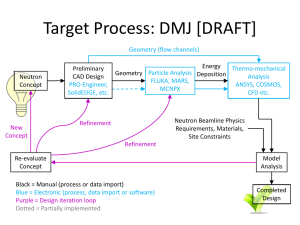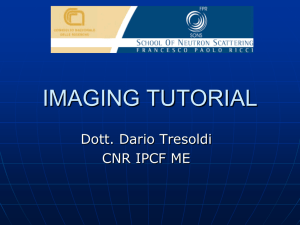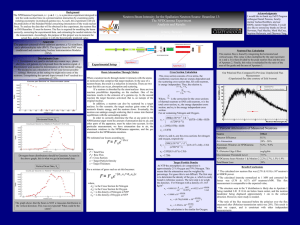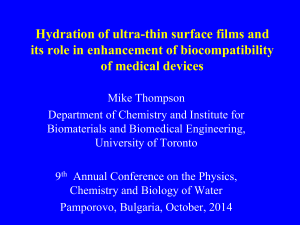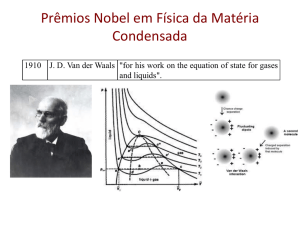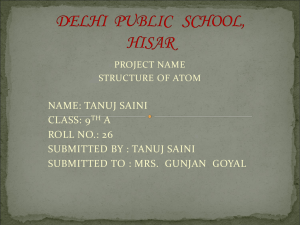谢金森
advertisement
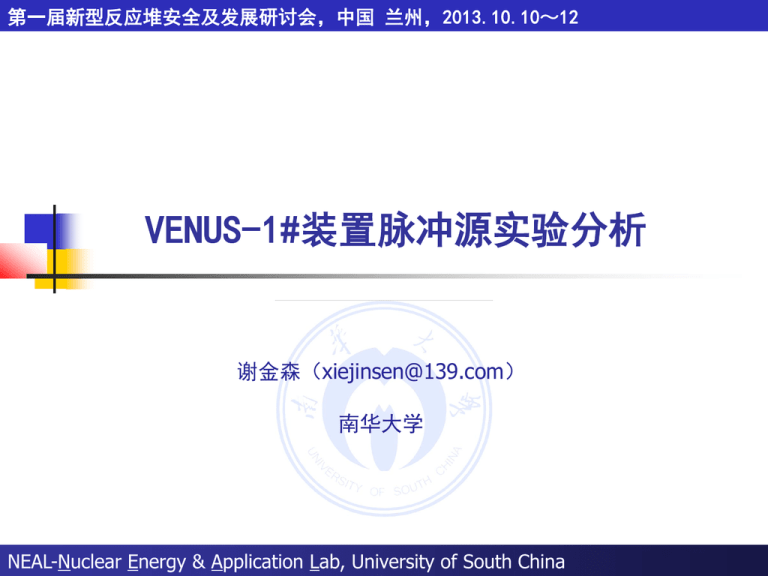
第一届新型反应堆安全及发展研讨会,中国 兰州,2013.10.10~12 VENUS-1#装置脉冲源实验分析 谢金森(xiejinsen@139.com) 南华大学 NEAL-Nuclear Energy & Application Lab, University of South China 第一届新型反应堆安全及发展研讨会 CONTENTS Background and Purpose Core Composition & PNS Experiment of VENUS-1# Preliminary Results from PNS Experiment Simulation of PNS Experiment on Certain Condition Comparison of Simulated and Experimental Results Summary & Future Suggestions 第一届新型反应堆安全及发展研讨会 BACKGROUND AND PURPOSE Background R&D on Accelerator Driven System for MA and LLFP Transmutation Supported by two “973” Projects The World-first Fast-Thermal Coupled ADS core- VENUS-1# has been built in 2005; Abundant research works on Sub-critical neutronics have been carried out on VENUS-1#. Supported by Chinese Academy of Science 5MWt~10MWt Pb-Bi cooled ADS core will be built (First-step, Critically Operation; Second-step, Accelerator coupling with subcritical core ); Although massive meaningful results has been obtained, some issues on Sub-criticality measuring still exist. 第一届新型反应堆安全及发展研讨会 BACKGROUND AND PURPOSE Background To support the development of sub-criticality measuring technique, Pulsed Neutron Source experiments on VENUS-1# has been performed 2005, VENUS-1# was coupled with CPNG (CIAE Pulsed Neutron Generator), five different Sub-critical levels; 2007, the first PNS experiment analysis work was published (Thesis of Shanghai Jiaotong Univ.) ; 2011, PNS experiment simulation work was performed, three different Sub-critical levels, D-T, 252Cf, Am-Be neutron sources(Thesis of CIAE). All the above works indicate: Prompt neutron attenuation constants depend on detectors’ locations & driven source energy. 第一届新型反应堆安全及发展研讨会 BACKGROUND AND PURPOSE Fuel pins of Thermal blanket 2046 2022 1998 1962 1926 Prompt neutron attenuation constants Detector_6th Detector_10th Detector_R Detector_S 1627.6±22.4 (1) 795.33 (2) 1716.2±26.4 840.02 1771.8±41.4 960.64 1823.6±14.4 967.85 1928.8±14.4 1119.50 1705.0±25.0 763.76 1702.0±14.4 832.11 1888.0±48.0 985.87 1922.4±16.4 985.87 1946.4±11.9 1076.40 2495.4±67.8 709.70 2426.2±23.4 758.17 3056.6±83.2 879.90 3868.8±32.2 921.40 4311.4±18.2 1076.40 1350.4±36.4 -1576.4±17.9 -1671.2±62.0 -1646.6±17.5 -1662.4±33.6 -- (1) Experimental results of CIAE; (2) MC simulation results of SJTU. 第一届新型反应堆安全及发展研讨会 BACKGROUND AND PURPOSE Purpose Confirm the results from former researches; Feasibility study of PNS method on Fast-thermal coupled core; Investigate the potentially special phenomenon of Fast-thermal coupled core under pulsed neutron condition. 第一届新型反应堆安全及发展研讨会 CORE COMPOSITION & PNS EXPERIMENT OF VENUS-1# Core Composition Main parameters of VENUS-1# External source region: coupled with accelerator, neutron tube, or isotopic neutron source; Fast spectrum blanket: natural uranium pins + aluminum block, 10 layers; Thermal spectrum blanket : 3wt% uranium pins+ CH2 block, 15 layers maximum; Reflector: CH2 block, 200mm thick; Shield: CH2+B, 200mm thick; 第一届新型反应堆安全及发展研讨会 CORE COMPOSITION & PNS EXPERIMENT OF VENUS-1# CPNG neutron generator (CIAE Pulse Neutron Generator ) Main parameters of CPNG Type: Cockcroft-Walton High voltage: 200~600kV Pulse beam frequency: 50~200Hz Pulse width:1~5us 第一届新型反应堆安全及发展研讨会 CORE COMPOSITION & PNS EXPERIMENT OF VENUS-1# Experimental conditions & instrument system Detectors Sub-criticalities: adjusted by thermal fuel pin loading; 1926, 1962, 1998, 2022, 2046; Detectors: 3 3He tubes (6th, 10th layer of fast blanket & reflector); 1 BF3 tubes (Shield) Electronic system: 60 multi-channels; 50us/channel; Data collection: 3 groups data; 105 pulses; statistical errors for first several channels < 1%; 第一届新型反应堆安全及发展研讨会 6th 10th R 0.12 S Thermal blanket with 1926 fuel pins 0.18 0.17 0.16 0.15 0.14 0.13 0.12 0.11 0.10 0.09 0.08 0.07 0.06 0.05 0.04 0.03 0.02 0.01 0.00 -0.01 Normarized Neutron Count Rate Normarized Neutron Count Rate PRELIMINARY RESULTS FROM PNS EXPERIMENT 6th 10th R S 0.10 0.08 0.06 0.04 0.02 0.00 0 10 20 30 40 50 0.17 0.16 0.15 0.14 0.13 0.12 0.11 0.10 0.09 0.08 0.07 0.06 0.05 0.04 0.03 0.02 0.01 0.00 -0.01 Normarized Neutron Count Rate 20 30 40 50 20 0.12 30 60 0 10 20 30 0.08 0.06 0.04 0.02 0.00 20 30 Chanel Number 40 40 Channel Number 6th 10th R S 0.10 10 50 60 6th 10th R S Thermal blanket with 2022 fuel pins Thermal blanket with 2046 fuel pins 0 40 0.070 0.065 0.060 0.055 0.050 0.045 0.040 0.035 0.030 0.025 0.020 0.015 0.010 0.005 0.000 Channel Number Normarized Neutron Count Rate 10 10 Channel Number 6th 10th 0.085 R 0.080 S 0.075 Thermal blanket with 1962 fuel pins 0 0 60 Channel Number Normarized Neutron Count Rate Thermal blanket with 1998 fuel pins 50 60 50 Fuel pins of Thermal blanket Prompt neutron attenuation constants 6th 10th R S 2046 1627.6±22.4 1705.0±25.0 2495.4±67.8 1350.4±36.4 2022 1716.2±26.4 1702.0±14.4 2426.2±23.4 1576.4±17.9 1998 1771.8±41.4 1888.0±48.0 3056.6±83.2 1671.2±62.0 1962 1823.6±14.4 1922.4±16.4 3868.8±32.2 1646.6±17.5 1926 1928.8±14.4 1946.4±11.9 4311.4±18.2 1662.4±33.6 60 第一届新型反应堆安全及发展研讨会 PRELIMINARY RESULTS FROM PNS EXPERIMENT Discussion on the experimental results Prompt neutron attenuation constants show strong spatial dependence; The attenuation constants obtained by detectors show large discrepancies; The experimental results conflict with theory of experimental reactor physics (lumped parameter Point Reactor Dynamics) ; Which attenuation constant should be used as a sub-critical indicator, or how to make spatial corrections. 第一届新型反应堆安全及发展研讨会 SIMULATION OF PNS EXPERIMENT ON CERTAIN CONDITION Theoretical considerations Harmonics neutron flux seriously affects detector responses in deep sub-critical condition (both static & transient ) ; For Fast-thermal coupled system, typical prompt neutron life time is 10-5 second, width of multi-channel should be correspond to the condition for better inferring of harmonics (can be easily realized in simulation); To obtain the prompt neutron attenuation constants (fundamental mode), harmonics should be filtered. 第一届新型反应堆安全及发展研讨会 SIMULATION OF PNS EXPERIMENT ON CERTAIN CONDITION Theoretical considerations In transient conditions, neutron flux can be expressed as: (r , t ) (r )T (t ) Consider Alpha Eigen-value problem, neutron density in PNS: N ( r , t ) S ( r )e S (r )e t t A0 (r )0 (r )e t Ai (r )i (r )e i t i 1 Contribution of external source t A0 (r)0 (r)e Contribution of fundamental Alpha mode Ai (r )i (r )e it Contributions of the ith harmonic Alpha modes 第一届新型反应堆安全及发展研讨会 SIMULATION OF PNS EXPERIMENT ON CERTAIN CONDITION Theoretical considerations Relationship of each attenuation constant: 1 2 i When harmonics and source contribution disappeared: N (r1 , t ) A (r ) (r ) 0 1 0 1 const N (r2 , t ) t t A0 (r2 )0 (r2 ) 0 第一届新型反应堆安全及发展研讨会 SIMULATION OF PNS EXPERIMENT ON CERTAIN CONDITION Methodology of simulation Simulation conditions: MCNP4CTM selected as PNS simulation code; 2046 thermal fuel pins loading for comparison with experiment; Multi-channel width set as 5us for better inferring harmonics effect, totally 600 channels (0~3000us, the same as experiment); Data processing technique: Detector response of R selected as benchmark; Relative responses to R used for fundamental attenuation time region search; 第一届新型反应堆安全及发展研讨会 SIMULATION OF PNS EXPERIMENT ON CERTAIN CONDITION Simulation results 6th 10th R S 2 10 6th/R 10th/R S/R 1000 1 0 10 S -1 10 10th R -2 10 -3 10 6th Relatived Neutron Count rate 100 -1 Relative Neutron Count(s ) 10 Fundamental decay mode 10 1 0.1 -4 10 0 100 200 300 400 500 600 Time(5s) Simulated detector responses 0.01 0 50000 100000 150000 200000 250000 300000 -8 Time(10 s) Simulated relative detector responses 第一届新型反应堆安全及发展研讨会 SIMULATION OF PNS EXPERIMENT ON CERTAIN CONDITION Simulation results Detector responses in time interval 500~3000us selected as fundamental attenuation constant fitting Detectors Alpha values Correlation coefficients 6th 10th R S 1430.30±8.71 1436.76±3.99 1436.60±3.49 1417.35±1.12 0.99087 0.99809 0.99853 0.99984 第一届新型反应堆安全及发展研讨会 COMPARISON OF SIMULATED AND EXPERIMENTAL RESULTS Comparison of detector responses The simulated data use the same channel width of experiment; Quite different attenuation trends observed. 6th 10th R S 10 Neutron count rate 0.1 Normarized Neutron Count Rate 100 1 0.1 0.01 6th 10th R S 0.01 1E-3 1E-3 0 10 20 30 40 Channel number Simulated data 50 60 0 10 20 30 40 50 Channel Number Experimental data 60 第一届新型反应堆安全及发展研讨会 COMPARISON OF SIMULATED AND EXPERIMENTAL RESULTS Comparison of Alpha constants Original experiment data; harmonics filtered simulated data; harmonics filtered experimental data. Normarized Neutron Count Rate 6th 10th R S Original Exp. data 0.1 6th 10th R S Original Experimental data 1627.6±22.4 1705.0±25.0 2495.4±67.8 1350.4±36.4 Harmonics filtered Experimental data 1664.2±55.8 1521.0±30. 2 2902.0±78. 7 1385.6±59.0 Harmonics filtered simulated data 1430.30±8.71 1436.76±3.99 1436.60±3.49 1417.35±1.12 0.01 1E-3 0 10 20 30 40 50 60 Channel Number B C D E Harmonics filtered Exp. Data(500~3000us) 0.1 Neutron Count rates Alpha values 0.01 1E-3 10 20 30 40 Channels(50s/channel) 50 60 第一届新型反应堆安全及发展研讨会 COMPARISON OF SIMULATED AND EXPERIMENTAL RESULTS Comparison of Alpha constants original experimental data; harmonics filtered simulated data; harmonics filtered experimental data. 3000 2800 The Alpha indicated by detector 10th has been improved; 2600 Alpha values 2400 Original experiment Alpha Simulated Alpha with harmonics filtering Original exp. data with harmonics filtering 2200 2000 The Alpha value obtained by detector S is closest to simulated one; 1800 The Alpha value of detector R still show big discrepancy. 1600 1400 1200 6th 10th Detector label R S 第一届新型反应堆安全及发展研讨会 COMPARISON OF SIMULATED AND EXPERIMENTAL RESULTS Verification of the simulated Alpha In one neutron generation time, the prompt neutron population: T (l ) T (0)k p For sub-critical system: T (l ) T (0)el Relationship between kp and Alpha: k p e l kp 6th 10th R S From α 0.92492 0.92460 0.92461 0.92558 0.94117±0.00266 MCNP △kp* -1.727% 1.761% 1.760% 1.656% 第一届新型反应堆安全及发展研讨会 SUMMARY & FUTURE SUGGESTIONS Summary Using relative neutron count rates as an indicator, time region for fundamental Alpha mode decay can be easily obtained (a harmonics filtering technique); The simulated data with harmonics filtering technique give a spatially independent prompt neutron attenuation constants; Some Alpha values from experiment is improved by harmonics filtering, however some other values are worsen. 第一届新型反应堆安全及发展研讨会 SUMMARY & FUTURE SUGGESTIONS Suggestions Since the big discrepancy between experiment and simulation, as well as the short neutron life time and harmonics influence in the Fast-thermal couple ADS core, more rapid electronics data collection system should be used in future PNS experiment; Although the harmonics filtering technique show the capability for Alpha measuring, the accuracy of calculated prompt neutron generation time plays a key role in verification work (consider the coupling between external neutron source region, fast blanket, thermal blanket and reflector, the effective generation time should be introduced, as well as its calculation theory) 第一届新型反应堆安全及发展研讨会 Thanks for your attention!
